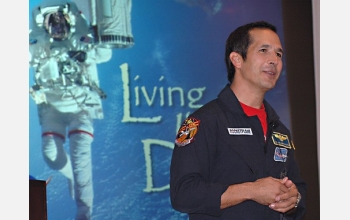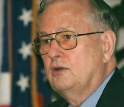News Release 05-204
Astronaut Says to Live Your Dreams in Observance of American-Indian Heritage Month
Member of Chickasaw Nation is the first Native American to walk in space

John Herrington is an aviator, astronaut and member of the Chickasaw Nation.
November 23, 2005
This material is available primarily for archival purposes. Telephone numbers or other contact information may be out of date; please see current contact information at media contacts.
Each November, the National Science Foundation (NSF) commemorates the many contributions American Indians and Alaska Natives make to science and engineering by inviting a distinguished guest speaker to address its workforce. On Nov. 14, 2005, U.S. Navy Capt. John Herrington, an enrolled member of the Chickasaw Nation of Oklahoma and the first American-Indian astronaut to serve with NASA, delivered his personal message: "Living Your Dreams."
He is now the chief test pilot for the XP Spaceplane under development by the company Rocketplane, Inc.
Herrington, who is also the first American Indian astronaut to walk in space, is well known among Indian educators as a role model for Indian children and youth. The audience included astronomy students from Washington-Lee High School in Arlington, Va.
National American Indian Heritage Month honors the contributions and accomplishments of American Indians and Alaska Natives to our society and country. The Boy Scouts of America were the first to dedicate a day to the "First Americans." New York was the first state to declare the second Saturday in May as American Indian Day in 1916. Illinois endorsed it in 1919.
In 1990, the President approved a joint resolution designating November 1990 as "National American Indian Heritage Month." In this year's proclamation, the president stated, "One of the most important ways to ensure a successful future is through education."
NSF programs seek to increase the participation and advancement of diverse groups and institutions at different levels of science, technology, engineering, mathematics, education and research. The Tribal Colleges and Universities Program, for example, promotes sustainable improvements of undergraduate science, technology, engineering and mathematics instruction and outreach programs, with an emphasis on expanding course and degree offerings, undergraduate research opportunities, and the use of information technologies at tribal colleges and universities, Alaskan Native-serving institutions and Native Hawaiian-serving institutions.
-NSF-
-
NSF Director Arden L. Bement, Jr., welcomed Herrington to NSF.
Credit and Larger Version -
Astonomy students from an Arlington, Va. high school were on hand for Herrington's talk.
Credit and Larger Version
Program Contacts
Consuela Roberts, NSF, (703) 292-7325, email: croberts@nsf.gov
The U.S. National Science Foundation propels the nation forward by advancing fundamental research in all fields of science and engineering. NSF supports research and people by providing facilities, instruments and funding to support their ingenuity and sustain the U.S. as a global leader in research and innovation. With a fiscal year 2023 budget of $9.5 billion, NSF funds reach all 50 states through grants to nearly 2,000 colleges, universities and institutions. Each year, NSF receives more than 40,000 competitive proposals and makes about 11,000 new awards. Those awards include support for cooperative research with industry, Arctic and Antarctic research and operations, and U.S. participation in international scientific efforts.
Connect with us online
NSF website: nsf.gov
NSF News: nsf.gov/news
For News Media: nsf.gov/news/newsroom
Statistics: nsf.gov/statistics/
Awards database: nsf.gov/awardsearch/
Follow us on social
Twitter: twitter.com/NSF
Facebook: facebook.com/US.NSF
Instagram: instagram.com/nsfgov




